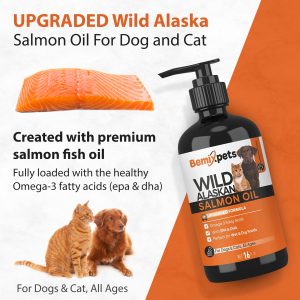Commercial food is produced and sold since the beginning of the twentieth century in America and after the Second World War in Europe.
This is a relatively recent diet, considering that the dog has been domesticated (according to recent studies) between 30,000 and 15,000 years ago.
The dog was born as a pet feeded with leftovers of human meals from the beginning (unlike the domesticated cat just to keep the mice away and almost never fed by the man), and it is natural that at some point it has been hypothesized (especially after a war, where food was scarce), to find a low-cost, nutritional product that could not be used directly by man.
The alternative, moreover, was the extinction of the dog, and indeed, due to the effects of the Wars, some races were extinct. Commercial food was then born as a complete and inexpensive food to feed the dog, and at the beginning it was meat scraps, and thanks to the invention of extrusion, it differed in various types including the well-known “dry food”. The dry food compared to the wet has the advantage of being stored for a long time and this has allowed it to spread.
But what happens to a dog eating only industrial food? Leaving aside any consideration of the quality of the particular product you give, you are still feeding your dog with a highly processed food. This, however, does not have the same quality as fresh food. They are not exaggerated, we know that in recent years there has been a similar reasoning in human nutrition and tends to disagree with the use of too much processed food.
So why should be good for a dog? My reasoning however begins with the assumption that I say to an owner: the croquette sucks! That's enough .. it will just go away .. but I think it's very important to make information and make it aware.
If you want to use dry food, at least choose the one that best suits your dog. In this article I will not even talk about various types of dry food based on their preparation (extrusion, cold pressing, etc), but I begin by telling you about the labels. Reading a label is not easy, it's not easy for anyone doing it as a job like me, it’s more difficult for an owner. But I can give you some basic information, from which you start to understand what you are doing and then maybe to get more in depth you can ask a professional (biologist or veterinarian nutritionist ... not the shopkeeper). I would like to emphasize that there is no perfect dry food, because industrial food is made for all dogs, but your dog is an individual and only a targeted diet can be customized to 100%.
How is a label made? In the packs you buy, you usually find: product name (XXX beef, or chicken, etc), ingredients and analysis table.
Product name
Do not rely on the name to understand what contains what you are buying. According to the FEDIAF (animal breeding federation regulations in Europe) tables, for example, if you have a rich formula in XXX, it only means that at least 14% of the product should contain that XXX.
Ingredients
The ingredient list contains all ingredients that are actually in the foods, in descending order of quantity at the time of processing. Attention, I write at the time of processing, because if for example you find fresh meat at 40%, in reality in the final product you’ll find much less because it is dehydrated and turned into flour before being inserted in the processing.
According to reports, the ingredients that go from the first to the first 90% of fat indicate the composition of the food. The rest is found in very small quantities. And indeed if you notice, often amount equal to or below 2% Max. The herbs that often are found at the end of the list are practically holograms of herbs.
Even if you find meat in the first place, not necessarily a dry food is filled with meat. You need to consider if the indication is on fresh meat or dehydrated or flour or boneless meat, etc.
Pay attention to other protein sources: hydrolyzed vegetable protein or potatoes, etc are used to increase the protein content if the source animal is poorly represented. Attention to ingredients split: If I find meat first and then corn, cornmeal, wheat, wheat flour, wheat, etc actually adding the sources of carbohydrates, pass the meat.
The ingredient list is a valuable tool, but unfortunately his reading is based on directions too broad and we can't have a firm guarantee of product quality. It is useful as a first step to assess it. Examples of ingredients (From European regulations concerning the discipline on the preparation of animal feed):
- flour of meat XXX: you get for heating, drying and grinding of the carcass of an animal, excluding hooves, hair, bristles, feathers, offal etc.
- flour of XX: is obtained from the heating, drying and grinding of by-products of animals.
- Animal “underproducts”: are all those parts of the animal are not intended for human consumption. Are included in the category: skin, hooves and horns, pig bristles, feathers and parts unfit for human consumption, blood, Greaves, defatted bones, kitchen waste, shells, hatchery derivatives, etc.
- Processed animal protein (dehydrated, dried, etc): animal protein obtained from by-products in order to make them eligible for feed.
- Meat: consists of at least 15% of the real meat, while the rest can be organs such as heart, kidney, liver, lung, aorta. Must not contain by-products.
Table of analysis
In the table of analysis shows the% of the minimum values of the main nutrients present in dry food. Beware, they are not precise values but values precisely minimums and may vary, in fact even of 10-15%. If you've ever read a label, you may have noticed that is never stated the amount of carbohydrates.
If you want to calculate this percentage you just add the% protein, fiber, fat, and whatever else is there, add if not indicated the approximate% of moisture (normally 8-10%) and subtract the number you get from 100. For example: 30% crude protein, crude fat 13%, crude fiber 3.6%, moisture 8%% carbohydrates is: 30 + 13 + 3.6 +8 = 54.6, 100-54 .6 = 45.4% carbohydrates (among other things a very high carbohydrate%).
A small separate discussion are the ashes, do not consider a high index% ash bad quality kibble. The ashes are just what remains of kibble and combustion can be obtained from the flesh, from the fibers and bones. If the ingredients are great, a high value of ashes tells us nothing. In addition, processed proteins such as meat, produce less ash, but they certainly don't have the same quality.
Of course these are just very basic concepts, then the kibble must be selected based on the needs of your dog, to his way of life, etc. But in principle, for a dog doing a normal life, choose dry foof with 28%/26%of proteins, not more carbohydrates then 30-32% (grain free) and with quality fats (not generic or generic oils fats, often a result of industrial production).
Some questions:
- The dry food allow optimal cleaning of teeth and prevent the formation of tartar?
As written above Kibbles contain at least 30% carbohydrates. A carbohydrate-rich food itself cannot clean your teeth, because the sugars are the main food of bacteria from plaque and Tartar. Also when is chewed, the croquette becomes sticky and creates precisely the breeding grounds for bacteria. The only way to clean your dog's teeth is giving something to munch on, but that does not contain many carbohydrates, then carrots, fennel, dried snacks, deer antler.
- Feeding with only dry food is complete and does not need supplements?
Yes, it's true. in theory has these features. However, there are plenty of studies that highlighted how the processing (extrusion) can significantly lower the bioavailability of proteins (especially lysine) and destroys vitamins. FAT do not like this process too.
That's why at the end of processing thanks to fat sprayed are added supplements and vitamins. But let us ask ourselves, who easily become rancid fats vitamins and sprayed with products that are not in their natural context, have the same bioavailability of vitamin a contained in a fresh vegetable for example? No, any chemist will tell you that a vitamin synthesized and taken by a vegetable fruit are exactly the same molecule, but the vitamin is absorbed better if it is in a context where there are also other substances. I made the example of vitamins but also applies to other integrations.
- The dry food can be served even wet?
Absolutely Yes. You make it more digestible. Why? Because any food to be digested needs before being hydrated. Take a kiddle that give your dog, put it in water and let it moisturize until flakes. That is the time it takes the dog from when he eats at when it finally starts to digest ... but in the meantime the stomach is li secreting gastric juices in liter.
Help digestion definitely. It is also not true that swells in the stomach after he ingested, however in the stomach will take all the water needed for hydrate at 100%. If you do it before or if it does after the dog drinking, will be achieved the same volume.






Leave a Reply
You must be logged in to post a comment.